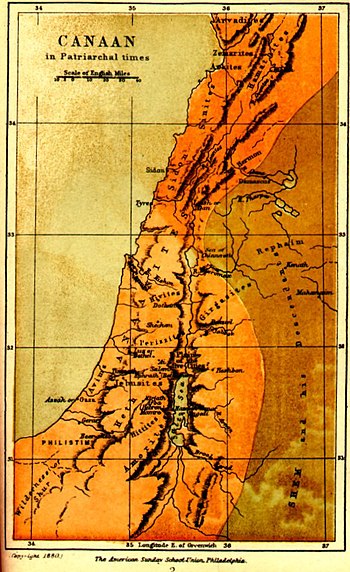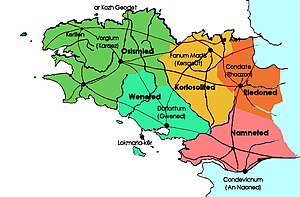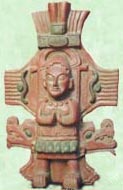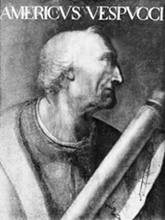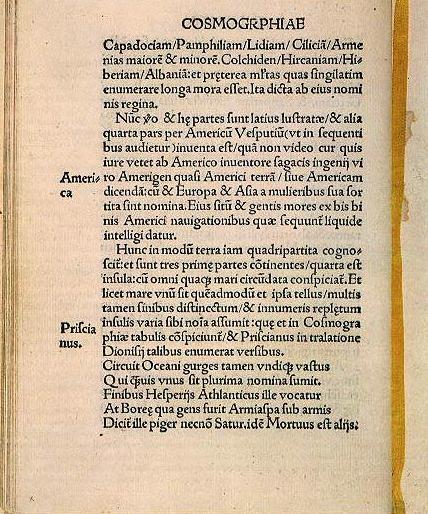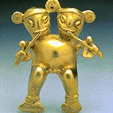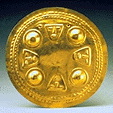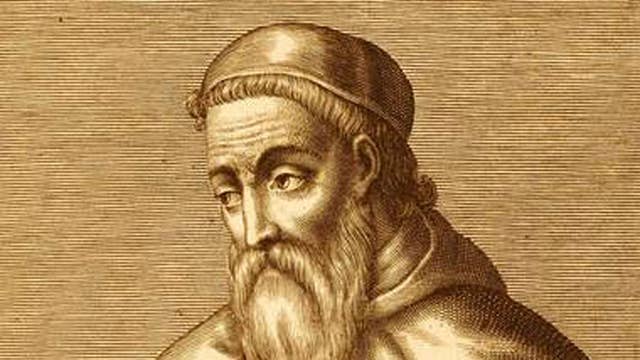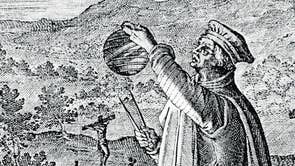I have never bought into the contrived fable we were fed about the origin of the name AMERICA. I never even really understood why our nation is called by multiple names. I knew that there was spiritual significance to the ROOT of the word AMERICA. Now I find that research proves there certainly is an abundance of meaning and significance.
As in my recent post where we looked at COLUMBIA and the root of that word-spell, today’s post is along the same or similar lines. It is lengthy, I don’t know any other way to present the material that would provide ample evidence and multiple witnesses.
Stay with me. There is a lot of truth to be gleaned here. TRUTH you really need to know.
As I present these things to you, I hope you understand that there is no one “nation” that we can point at and blame for all the evil in the world. However, there is a group that is responsible, influenced by a supernatural force that drives them. That Group, is the source of all unrighteous pagan religions, all magic, all false “science”, most wars, and the monetary system. There are people in every tribe and nation, that were born of the blood of the fallen, and there are those that have bought into the dark side and are under the spell of the MAGI.
spacer

I have to say that I was impressed when I heard Tim Alberino share this information. It made sense to me. In my opinion there is truth to this theory. However, it is not all inclusive. There are many sources and many spellings and many definitions for the term America. I believe that most are valid, and all have the same root.
The Oddcast Ft. The Odd Man Out
America = Amaruca-Land of The Plumed Serpent? Origins of The Name•
There’s fairly strong evidence that the name “America” was not an ode to the Italian explorer Amerigo Vespucci as we’ve been taught in our govt. indoctrination classes, but instead, after the Peruvian god, Amaruca. I haven’t made up my mind yet, but i urge you to check out these links, & videos.
I think you’ll find them as interesting as i do.
Manly P. Hall, author, lecturer 33rd Degrees Freemason, & Rosicrucian stated: “the name “America” is derived from “the God Quetzalcoatl in Mexico, Gucumatz in Quiché; and in Peru he was called Amaru. From the latter name comes our word America. Amaruca is, literally translated, ‘Land of the Plumèd Serpent.’ The priests of this God of Peace, from their chief centre in the Cordilleras, once ruled both Americas.”
Alberino Analysis, Land of The Plumed Serpent Pt.1 (America)
https://youtu.be/dnJA3jtqOVk
William (Bill) Cooper-Land of The Plumed Serpent “Minute 14:00
http://remnantradio.org/…/William…/Mystery%20Babylon/MB3.htm
Secret Mysteries of American’s Beginnings
https://m.youtube.com/watch?v=IXkzIWYpPXw
spacer










Coordinates: 49.748454°N 5.151091°E
The Château des Amerois is a 19th-century neo-gothic style castle in the Ardennes forest, south-east of Bouillon, Belgium. Replacing an original building destroyed by fire, the current castle was built from 1874 to 1877 for Prince Philippe, Count of Flanders.
spacer
The American Ecclesiastical Review, Volume 35
edited by Herman Joseph Heuser pg. 537 Recent Bible Study

spacer
By: W. Max Muller, Kaufmann Kohler
—Biblical Data:The descendants of the fourth son of Canaan (Gen. x. 16, I Chron. i. 14).
|
Canaan (son of Ham) From Wikipedia, the free encyclopedia Canaan (Hebrew: כְּנַעַן – Kənáʿan, in pausaכְּנָעַן – Kənā́ʿan), according to the Book of Genesis in the Hebrew Bible, was a son of Ham and grandson of Noah, and was the father of the Canaanites. EtymologyThe English term Canaan (pronounced /ˈkeɪnən/ since c. AD 1500, due to the Great Vowel Shift) comes from the Hebrewכנען (knʿn), via Greek Χαναάν Khanaan and The etymology is uncertain. One explanation is that it has an original meaning of “lowlands”, from a Semitic root knʿ “to be low, humble, depressed“, in contrast with Aram, “highlands”.[2] An alternative suggestion derives the term from Hurrian Kinahhu, purportedly referring to the colour purple, so that Canaan and Phoenicia would be synonyms (“Land of Purple”), but it is just as common to assume that Kinahhu was simply the Hurrian rendition of the Semitic knʿn.[3][4] Descendants of CanaanAccording to the Table of Nations in Genesis 10 (verses 15-19), Canaan was the ancestor of the tribes who originally occupied the ancient Land of Canaan: all the territory from Canaan’s descendants, according to the Hebrew Bible, include:
According to traditional Ethiopian histories, Canaan’s son Arwadi (lit. “the Arvadite”) and his wife Entela crossed from Asia into Ethiopia in 2101 BC, and the Qemant tribe were said to be descended from their son, Anayer. There is further an Ethiopian tradition that two other Canaanite tribes, viz. the Sinites and Zemarites, also entered Ethiopia at the time it was ruled by the Kingdom of Kush, and became the Shanqella and Weyto peoples, respectively.[6] The Qemant relate that they share their Canaanite origin with the other Agaw groups.[7] The Omotic speaking Shinasha have a similar tradition of descent from Canaan’s son Hamati[8] Similarly, the Shinasha extend the Canaanite ancestry to neighboring ethnic groups[9] The Persian historian Muhammad ibn Jarir al-Tabari (c. 915) recounted a tradition that the wife of Canaan was named Arsal, a daughter of Batawil son of Tiras, and that she bore him the “Blacks, Nubians, Fezzan, Zanj, Zaghawah, and all the peoples of the Sudan.”[10] Likewise, Abd al Hakam tells that “Canaan is the father of the Sudan (Sub Saharan Africans) and the Abyssinians”.[11] The German historian Johannes Aventinus (fl. c. 1525) recorded a legend that Canaan’s sons the “Arkite” and the “Hamathite” first settled in the area of Greece, and gave their names to the regions of Arcadia and Emathia. Curse of CanaanAccording to Genesis 9:20–27, Noah became drunk then cursed his grandson Canaan, for the transgression of Canaan’s father, Ham. This is the Curse of Canaan, to which the misnomer[12] “Curse of Ham” has been attached since Classical antiquity.[13]
Canaan in JubileesAnd Ham divided amongst his sons, and the first portion came forth for Cush towards the east, and to the west of him for Mizraim, and to the west of him for Put, and to the west of him [and to the west thereof] on the sea for Canaan. —Jubilees 9:1[18]
|
They form part of the ancient inhabitants of Palestine (Gen. xv. 21; Ex. iii. 8, 17, xxiii. 23; Joshua, iii. 10, xxiv. 11; I Kings, ix. 20; Ezek. xvi. 3, 45; also Isa. xvii. 9, where we ought probably to follow the Septuagint reading, “the forsaken places of the Amorites and the Hivites”). As representatives of the whole pre-Israelitish population, they are mentioned in Gen. xv. 16, xlviii. 22; Joshua, v. 1, xxiv. 15, 18; Judges, x. 11; I Sam. vii. 14; I Kings, xxi. 26; II Kings, xxi. 11; Amos, ii. 9, etc.
Geographical Distribution.Some scholars claim that (I Sam. vii. 14) Philistines and Amorites are synonymous, so that the latter expression would include all non-Israelitish inhabitants of Palestine. Usually, however, the passage in question is interpreted to mean the isolated remnants of the Amorites, who in pre-Philistine and pre-Israelitish times had occupied a large part of the country west of the Jordan. Their territory is more exactly defined as follows:
(a) In the south they inhabit the hill-country of the Amorites (Deut. i. 7, 19) on one side of the Canaanites (ibid. verses 27, 44), north of Kadeshbarnea. The Amorites in Hazezon-tamar (Gen. xiv. 7) and Mamre (ver. 13) belong to the same region.
(b) More to the north Joshua, x. 5, mentions five kings of the Amorites; namely, in Jerusalem, Hebron, Jarmuth, Lachish, and Eglon, as “all the kings of the Amorites that dwell in the hill-country”; compare ver. 12. According to II Sam. xxi. 2, Gibeon also was Amoritish (Joshua, xi. 19: Hivitish), although it is more probable that the name Amorite has there the vague meaning discussed above, without precise ethnological signification. We find the “Amorites which were beyond Jordan, westward” (Joshua, v. 1, xxiv. 8), distinguished from the “Canaanites which were by the sea” (ibid. v. 1); Joshua, xi. 3, apportions the hill-country to the Amorites, together with three other nations, distinguishing them from “the Canaanites on the east and on the west.” According to Judges, i. 34 [A. V. 35], however, at a somewhat later period, the Amorites dwelling “in Mount Heres, in Aijalon, and in Shaalbim,” whose border began “from the ascent of Akrabbim,” did not allow the Danites “to come down to the valley” and “forced them into the hill-country,” although the Amorites afterward became subject to Israel. It is questionable if a remnant of the Amoritish territory properly speaking is meant; more probably the name Amorite has again the general meaning. One is even tempted to understand it as used of the Philistines (as I Sam. vii. 14; see above).
(c) Amorites dwell east of the Jordan (Num. xxi. 13): the Arnon is the frontier between Moab and the Amorites. This land of the Amorites reaching “from Arnon to Jabbok, even unto the children of Ammon” (ibid. 24), had been taken away from Moab by Sihon (ibid. 24, 26, 29), who built Heshbon to be his residence (ibid. 26, 27) directly before the immigration of Israel. Amorites dwelling in Jazer are specially mentioned (ibid. 32). These Amorites “which dwelt beyond Jordan” are also referred to (Deut. i. 1, 4, iii. 2; I Kings, iv. 19; Ps. cxxxv. 11, cxxxvi. 19; Josh. ii. 10, ix. 10). Og, king of Bashan in Ashtaroth, is also called an Amorite in Deut. iii. 8, iv. 47, where we learn that Og’s territory extended “from the river of Arnon unto Mount Hermon.” So the land of the Amorites, which is in Gilead (Judges, x. 8), seems to have embraced all the territory afterward owned by Israel, east of the Jordan. Deut. iii. 9 informs us that the name of Mount Hermon in the language of the Amorites was Shenir.
Masters of Witchcraft.—In Rabbinical and Apocryphal Literature: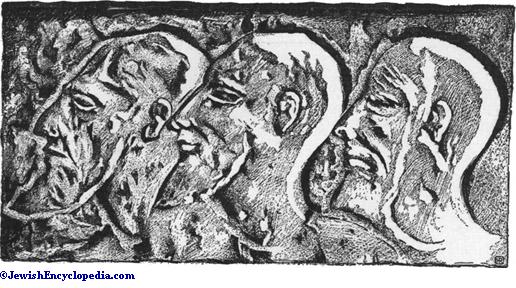 Amorites.(From the pylon of the Ramesseum.)In Tosef., Shab. (vii. [viii.] 23), and generally in post-Biblical literature, the Canaanites are usually spoken of as the Amorites (compare Assumptio Mosis, xi. 16; B. M. 25b); and they were characterized by R. Jose, the chronicler, as the most intractable of all nations. To the apocryphal writers of the first and second pre-Christian century they are the main representatives of heathen superstition, loathed as idolaters, in whose ordinances Israelites may not walk (Lev. xviii. 3). A special section of the Talmud (Tosef., Shab. vi.-vii. [vii.-viii.]; Bab. Shab. 67a et seq.) is devoted to the various superstitions called “The Ways of the Amorites.” According to the Book of Jubilees (xxix. [9] 11), “the former terrible giants, the Rephaim, gave way to the Amorites, an evil and sinful people whose wickedness surpasses that of any other, and whose life will be cut short on earth.” In the Syriac Apocalypse of Baruch (lx.) they are symbolized by “black water” on account of “their black art, their witchcraft and impure mysteries, by which they contaminated Israel in the time of the Judges.” This refers to the strange story of Kenaz, preserved in the “Chronicle of Jerahmeel” (Cohn in “Jew. Quart. Rev.” 1898, pp. 294 et seq., and translation of Gaster, p. 166), which relates how the tribes of Israel learned all their wickedness from the Amorites, the masters of witchcraft, whose books they kept hidden under Mount Abarim, and whose wonder-working idols—seven holy nymphs—they had concealed beneath Mount Shechem. Each of these idols was adorned with precious stones, which shone at night like the light of day, and by their power sight was restored to the blind. Kenaz, the son of Caleb and father of Othniel, when hearing of this, forthwith destroyed the idolatrous Israelites by fire, but tried in vain to destroy either the magic-books or thestones. So he buried the books, but in the morning found them transformed into twelve precious stones, with the names of the twelve tribes of Israel engraved thereon, and later they were used in Solomon’s Temple. Then, with the help of the angel Gabriel, he smote the Amorites with blindness and destroyed them with his sword.
Amorites.(From the pylon of the Ramesseum.)In Tosef., Shab. (vii. [viii.] 23), and generally in post-Biblical literature, the Canaanites are usually spoken of as the Amorites (compare Assumptio Mosis, xi. 16; B. M. 25b); and they were characterized by R. Jose, the chronicler, as the most intractable of all nations. To the apocryphal writers of the first and second pre-Christian century they are the main representatives of heathen superstition, loathed as idolaters, in whose ordinances Israelites may not walk (Lev. xviii. 3). A special section of the Talmud (Tosef., Shab. vi.-vii. [vii.-viii.]; Bab. Shab. 67a et seq.) is devoted to the various superstitions called “The Ways of the Amorites.” According to the Book of Jubilees (xxix. [9] 11), “the former terrible giants, the Rephaim, gave way to the Amorites, an evil and sinful people whose wickedness surpasses that of any other, and whose life will be cut short on earth.” In the Syriac Apocalypse of Baruch (lx.) they are symbolized by “black water” on account of “their black art, their witchcraft and impure mysteries, by which they contaminated Israel in the time of the Judges.” This refers to the strange story of Kenaz, preserved in the “Chronicle of Jerahmeel” (Cohn in “Jew. Quart. Rev.” 1898, pp. 294 et seq., and translation of Gaster, p. 166), which relates how the tribes of Israel learned all their wickedness from the Amorites, the masters of witchcraft, whose books they kept hidden under Mount Abarim, and whose wonder-working idols—seven holy nymphs—they had concealed beneath Mount Shechem. Each of these idols was adorned with precious stones, which shone at night like the light of day, and by their power sight was restored to the blind. Kenaz, the son of Caleb and father of Othniel, when hearing of this, forthwith destroyed the idolatrous Israelites by fire, but tried in vain to destroy either the magic-books or thestones. So he buried the books, but in the morning found them transformed into twelve precious stones, with the names of the twelve tribes of Israel engraved thereon, and later they were used in Solomon’s Temple. Then, with the help of the angel Gabriel, he smote the Amorites with blindness and destroyed them with his sword.
Thus Amorite would be the more ancient name, obscure even to the earliest writers. It is not certain that these writers were influenced by the etymology of the word. If Amorites were equivalent to “highlanders,” we should have to compare the application of the name to the highland of Judah (Num. xiii. 29; Deut. i. 7, 19, 20; Josh. v. 1, x. 6, xi. 32) as a secondary use or as a mere inference from the etymology. At present, however, that etymology has been discarded, as amir means “summit,” not “mountains” or “highland.” The Egyptian inscriptions, indeed, seem to treat the name of the original country Amor as a geographical term, always connecting it with the article, while Amorite is in the Bible an ethnic name. How the Amorites, or at least their name, came to Palestine, still awaits plausible explanation.
Bibliography:
Sayce, Races of the Old Testament, 1891, pp. 100 et seq.
spacer
If you have been following my work, you know that we have uncovered a great deal about Switzerland. If you have not been following me… there are a few artiles you might want to reveiew:
Temple of BAAL – BERN Switzerland – Part 1 – The Event and the Town
Temple of BAAL – BERN Switzerland – Part 2 – Unveiling the Connections
Temple of BAAL – BERN Switzerland – Part 3 -BERN, SWITZERLAND; LONDON, ENGLAND; New York, NY- USA; – What do they have in common??
Temple of BAAL – LUXEMBURG – ARCH of TRIUMPH or should we say VICTORY?
spacer
What Do The Netherlands And The Us Have In Common?
The Dutch who came to America brought their own language with them, and the American language of today still contains a number of their words. With the game kolf the word `golf’ stuck, with skating the word `skate’ from schaats. The Dutch seafaring tradition brought the words `skipper,’ `marine’, ‘hoist,’ `yacht’ and many others some by way of (British) English, some directly into American speech. `Yankee’ itself is supposedly a corruption of the Dutch name Jan-Kees, very popular in the seventeenth century. ‘Boss’ comes from the Dutch word baas. (Etymology. From Dutch baas (“boss”), from Middle Dutch baes (“master of a household, friend”), from Old Dutch *baso (“uncle, kinsman”), from Proto-Germanic *baswô.) And even the word ‘cuspedor’ (spittoon) seems to come from the Dutch kwispedoor, but that may also be the other way around.
In the pursuit of things Dutch in the United States, some historians have compiled long lists of prominent Americans of Dutch descent, as, for instance, James Madison, Martin van Buren, Zachary Taylor, Ulysses S. Grant, Jefferson Davis, and Theodore and Franklin D. Roosevelt, who are both descendants of a Klaes Martensen van Roosevelt, a farmer from Tholen who settled in New Netherland in the 1640’s. And on another level, we should not forget Eddie van Halen, Rutger Hauer, Paul Verhoeven, Adam Curry and Willem de Koning.
4a. New Netherland to New York
England was not the first European power to settle the land known now as New York. That distinction belongs to the Dutch.
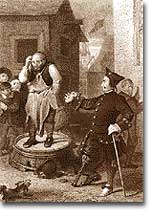 Governor Stuyvesant, appointed by the Dutch West India Company, told the colonists of New Netherland, “I shall govern you as a father his children.”
Governor Stuyvesant, appointed by the Dutch West India Company, told the colonists of New Netherland, “I shall govern you as a father his children.”Ironically, the English explorer Henry Hudson brought the region to the attention of the Netherlands in 1609 by sailing into New York Bay and up the river that would eventually bear his name.
New Netherland became a reality fourteen years later. The Dutch West India Company hoped to reap the profits of the area’s fur trade.
Wait Just a Minuit
Shortly after setting up camp, Peter Minuit made one of the greatest real estate purchases in history. He traded trinkets (small ornaments, jewelry, etc.) with local Native Americans for Manhattan Island. The town that was established there was named New Amsterdam.
The Dutch had no patience for democratic institutions. The point of the colony was to enrich its stockholders.
The most famous governor of the colony, Peter Stuyvesant, ruled New Amsterdam with an iron fist. Slavery was common during the Dutch era, as the Dutch West India Company was one of the most prominent in the world’s trade of slaves.
Languages that could be heard in the streets of New Amsterdam include Dutch, French, Flemish, Swedish, Danish, Finnish, and several other European and African tongues. (All places known to be influenced and/or ruled by the DRUIDS)
Northwest of New Amsterdam, New Netherland approached feudal conditions with the awarding of large tracts of land to wealthy investors. This would create eventual instability as the gap between the landed and the landless grew more obvious. (Sound familiar? Just what the NEW WORLD ORDER is doing. Why? Because they are ruled by the same DRUID/MAGI/PAGAN spirits.)
The British Are Coming
After Charles II came to the throne, the English became very interested in the Dutch holdings. In 1664, he granted the land to his brother, the Duke of York, before officially owning it.
When a powerful English military unit appeared in New Amsterdam, Governor Stuyvesant was forced to surrender and New Netherland became New York. (From where the elite still rule the USA, and where the NETHERLANDS RULE via the United Naitons)
Santa Claus and Easter Eggs
Cultural contributions left by the Dutch include the pastimes of bowling and skating. Christmas and Easter were transformed (PAGANIZED) by the introduction of Santa Claus and Easter eggs.
Any resident or visitor to Harlem or Brooklyn should recognize the Dutch influence in the names of locales. Although majority Dutch presence was short-lived, the legacy remains.
But it is somewhat silly if such lists are made to boast that Holland deserves part of the credit for these men’s deeds. After all, their ancestors left Holland and chose a new country. More vital in the relation between The Netherlands and the United States than common words or ancestries are common beliefs and shared interests.
Some say that there is something of the best of Holland in the best American institutions, and of that it can be justifiably proud. This `something’ is an idea, which we can trace back to Erasmus and the sixteenth-century Netherlands. We find its spirit in a statement issued by the town of Leyden in the year 1581. At stake was an order from the central authorities to control and censure the printing of books. The town magistrates refused to comply, and used the occasion to express their belief in the sovereignty of the free individual. `Reason,’ they wrote, `which is the adversary of all tyrants, teaches us that truth can be as little restrained as light.’
It was in this tradition Nieuw Amsterdam spread tolerance in an intolerant age among intolerant people. (Sound familiar? Tolerance is the watchword of the NEW WORLD ORDER. Tolerance for anything at all EXCEPT belief in the Word of GOD)
Following up on this, back to the origins of the two countries, we find a striking parallel in the documents recording their births. Both countries won their independence by rebellion (one from Spain, the other from England), and each thought it vital to put the essentially moral character of its rebellion into words.
When the Dutch abjured the Spanish king in the year 1581, they had the same ‘legalistic’ approach as the Americans later and they declared to the world:
`As it is apparent to all that a prince is constituted by God to be the ruler of the people… and whereas God did not create the people slaves to their prince, to obey his commands, whether right or wrong, but rather the prince for the sake of the subjects… And when he does not behave thus, but on the contrary oppresses them… they may not only disallow his authority, but legally proceed to the choice of another prince for their defence…’
Aren’t these words reminiscent of Jefferson’s text in the American Declaration of Independence:
`we hold these truths to be self-evident, that all men… are endowed by their Creator with certain unalienable rights :… that to secure these rights, governments are instituted among men, deriving their just powers from the consent of the governed; that whenever any form of government becomes destructive of these ends, it is the right of the people to alter or to abolish it and to institute new government…’
We do not know whether Jefferson ever studied the Dutch war of Independence, but – given the changes caused by the political thinking of the two centuries that separate them – the two declarations seem inspired by the same spirit. We do know however that the example of the Dutch Republic was very vivid in the minds of people that shaped the American constitution. Not only did it serve as a positive example, but the weakness of the Dutch Republic at the end of the eighteenth century caused by internal strife and the incapability to come to decisions installed the notion of a the need of a strong executive in the United States.
The belief in the reason of the free mind, the belief in humanity and tolerance, were the best things the Netherlands ever had to offer. They are equally part of the best American tradition. If the Netherlands and the Dutch settlers have helped their growth here, in whatever small a way, then that is the greatest contribution they could make. The very nature of these beliefs leads us away from our national prides and prejudices, and causes us to turn our thoughts to what unites us all. (Familiar once again!! The Dutch/Netherlands seem to be the root of the NEW WORLD ORDER.)
spacer
DUTCH CULTURAL PROFILE
July 2012
The national anthem is the Wilhelmus – a rebel song stemming from the independence war against Spain and was adopted as the national anthem in 1932. To listen to the anthem go to http://www.nationalanthems.info/nl.htm and click on the MP3 to listen. Usually only the first two verses are sung.
The complex relationship the Dutch people have with the sea is also notable. The Dutch take great pride in their struggle against the sea and the reclaiming of land which they view as their mastery over nature.
National symbols
The display of the national flag and the singing of the national anthem are important expressions of identity for a decreasing number of citizens.
The flag consists of three horizontal stripes in the colours red, white, and blue. Very often there is an orange wimple attached to show loyalty to the house of Orange.
Orange is the Dutch national colour and is worn at major sporting events and special days such as Queen’s Day which celebrates Queen Beatrix’s birthday
Dress
These days Dutch people wear the same sort of clothes that other people in Europe wear. Each area of The Netherlands had its own costume, so that there are actually many traditional Dutch costumes.
 The most well-known part of the traditional Dutch costume are the wooden clogs. (Do you remember the clog on the JADE HELM logo?) Long ago, only very rich people could afford leather shoes and so ordinary people wore shoes made of wood. The shapes of the clogs were all different and depended on what area of the Netherlands they came from.
The most well-known part of the traditional Dutch costume are the wooden clogs. (Do you remember the clog on the JADE HELM logo?) Long ago, only very rich people could afford leather shoes and so ordinary people wore shoes made of wood. The shapes of the clogs were all different and depended on what area of the Netherlands they came from.
Today, some people working in the countryside still wear them
occasionally as they are cheaper and easier to wear than gumboots.
spacer
Amergin, also spelled Amorgen, Amairgin, Aimhirghin, Amorghain, may refer to:
- Amergin Glúingel, poet and druid of the Irish Mythological Cycle
- Amergin mac Eccit, poet and hero of the Irish Ulster Cycle
- Amergin of Maigh Seóla (fl. 550), father of Finbarr of Cork, Ireland
- Amergin, a crater on Europa
spacer
Meaning of Amorica
Amorica is Girl/Female and origin is English
Amorica means: Britain.
spacer
Armorica: the name given in ancient times to the part of Gaul that includes the Brittany peninsula and the territory between the Seine and Loire rivers inland to an indeterminate point → Armorica was the birthplace of Sir Amory Tristram, 1st Earl of Howth, and the place where the legendary Tristan spent his youth
North America: the New World in which the history of the Old World repeats itself Viconianly
| A Finnegans Wake Gazetteer |
North Armorica:
|
Based on the above, North Armorica: = Lofty love felt by the mind (vs. the loins). To be in “North Armorica” is to have your mind within the land of love. The type of love that shields you from reason and that you defend against all reproach.
|
Armorica: Arthur Rimbaud, Une saison en enfer: “Me voici sur la plage armoricaine. Que les villes s’allument dans le soir. Ma journée est faite; je quitte l’Europe.” (“Here I stand at the Armorican beach. Let the cities light up in the night. My day is done; I leave Europe.”)
spacer
I decided to include this bit of information because it clearly states that the lands that the explorers called the “New World” as clearly known to the Siamese at least a couple CENTURIES prior.
In concluding the evidence for the existanoe of syphilis in the Far East, in remote times, it might be well to mention that the Siamese h~ve generic names for both
syphilis and tobacco (19). Thus, from this faot, we are led to believe that at least two of the products alleged to have originated in the Americas were known to the Siamese ·
at some remote date which probably antedated the discovery of America by several centuries.
spacer
Armorica
The Roman geographical area of Armorica. The Seine and the Loire are marked in red.
Armorica or Aremorica is the name given in ancient times to the part of Gaul between the Seine and the Loire that includes the Brittany Peninsula, extending inland to an indeterminate point and down the Atlantic Coast.[1] The toponym is based on the Gaulish phrase are-mori “on/at [the] sea”, made into the Gaulish place name Aremorica (*are-mor-ika) “Place by the Sea” (“Ar y Mor” has the same meaning in modern Welsh). The suffix -ika was first used to create adjectival forms and then names (see regions such as Pays d’Ouche from Utica and Perche from Pertica). The original designation was vague, including a large part of what became Normandy in the 10th century and, in some interpretations, the whole of the coast down to the Garonne. Later, the term became restricted to Brittany.
In Breton, which belongs to the Brythonic branch of the Insular Celtic languages, along with Welsh and Cornish, “on [the] sea” is war vor (Welsh ar fôr, “f” being voiced and pronounced like English “v”), but the older form arvor is used to refer to the coastal regions of Brittany, in contrast to argoad (ar “on/at”, coad “forest” [Welsh ar goed or coed “trees”]) for the inland regions.[2] The cognate modern usages suggest that the Romans first contacted coastal people in the inland region and assumed that the regional name Aremorica referred to the whole area, both coastal and inland.
History
Map of Briton settlements in the 6th-century, including what became Brittany and Britonia (in Spain).
Pliny the Elder, in his Natural History (4.17.105), claims that Armorica was the older name for Aquitania and states Armorica’s southern boundary extended to the Pyrenees. Taking into account the Gaulish origin of the name, that is perfectly correct and logical, as Aremorica is not a country name but a word that describes a type of geographical region, one that is by the sea. Pliny lists the following Celtic tribes as living in the area: the Aedui and Carnuteni as having treaties with Rome; the Meldi and Secusiani as having some measure of independence; and the Boii, Senones, Aulerci (both the Eburovices and Cenomani), the Parisii, Tricasses, Andicavi, Viducasses, Bodiocasses, Veneti, Coriosvelites, Diablinti, Rhedones, Turones, and the Atseui.
Trade between Armorica and Britain, described by Diodorus Siculus and implied by Pliny[3] was long-established. Because, even after the campaign of Publius Crassus in 56 BC, continued resistance to Roman rule in Armorica was still being supported by Celtic aristocrats in Britain. Julius Caesar led two invasions of Britain in 55 and 54 in response. Some hint of the complicated cultural web that bound Armorica and the Britanniae (the “Britains” of Pliny) is given by Caesar when he describes Diviciacus of the Suessiones as “the most powerful ruler in the whole of Gaul, who had control not only over a large area of this region but also of Britain”[4] Archaeological sites along the south coast of England, notably at Hengistbury Head, show connections with Armorica as far east as the Solent. This ‘prehistoric’ connection of Cornwall and Brittany set the stage for the link that continued into the medieval era. Still farther East, however, the typical Continental connections of the Britannic coast were with the lower Seine valley instead.
A Celtic stater made from billon alloy found in Armorica
Map of the Gallic people of modern Brittany :

History
They survived into Roman times and are found in the texts of Julius Caesar, Pliny the Elder, and Strabo.[9] They submitted to Caesar during the Gallic Wars, in 57 BC. The next year, they revolted along with the Veneti, but were put down. They became a Roman civitas and their identity survived into Late Antiquity.
Veneti – Veneti (Gaul) From Wikipedia, the free encyclopedia: This article is about the Veneti of northwestern Gaul. For other peoples called Veneti, see Veneti (disambiguation).
A seafaring people, they strongly influenced southwestern Brittonic culture by their trade. After they were defeated by Junius Brutus Albinus in a naval battle in 56 BCE, their maritime commerce eventually declined under the Roman Empire, but a prosperous agricultural life is indicated by archaeological evidence.[3]
History
After the bloody fight on the Sambre (57 BCE) Julius Caesar sent Publius Licinius Crassus with a single legion into the country of the Veneti, Redones, and other Celtic tribes between the Seine River and the Loire, all of whom submitted. (B. G. ii. 34.) Caesar here enumerates the Redones among the maritime states whose territory extends to the Atlantic Ocean. In 52 BCE the Redones with their neighbors sent a contingent to attack Caesar during the siege of Alesia. In this passage also (B. G. vii. 75), the Redones are enumerated among the states bordering on the ocean, which in the Celtic language were called the Armoric States. D’Anville supposes that their territory extended beyond the limits of the diocese of Rennes into the dioceses of St. Malo and Dol-de-Bretagne.

They were neighbours to the Veneti people (north-west), the Redones (North), the Andecavi (east) and the Pictones (south).In the spring 56 BC during the Gallic wars and according to Caesar, the Namnetes allied to the Veneti to fight against the fleet made by Caesar.[2] Decimus Brutus, leader of the Roman fleet, finally won the battle.[3]During Roman domination, the Namnete capital city was located at the confluence of the Loire and the Erdre; its name was probably Condevicnum.[4] During the 3rd century AD, the city became known as Portus Namnetum,[5] then Nantes in the Middle Ages.
Samnitae/Namnete Women’s Island
According to Strabo, quoting Poseidonios, there is an island in the Ocean near the outlet of the Loire river which was inhabited by the “women of the Samnitae,” (Amazons?) which is generally taken to be a mistake and actually refers to the “Namnitae” or Namnetes.[12] No man was ever allowed on the island and the women themselves sailed from it to have intercourse with men on the continent before returning there again. They also had the strange custom of unroofing their temple every year and roofing it again on the same day before sunset, each woman bringing her load to add to the roof. The woman whose load would fall out of her arms was rent to pieces by the rest, and they allegedly carried the pieces round the temple with the cry of “Ev-ah” in a frenetic manner.[13]
According to French archaeologist Jean-Louis Brunaux, there are three reasons to consider the story as factual. First, the wet and windy climate of Western Gaul suggest that the Gallic dwellings (made of branches or reed) were re-roofed every year. Second, not to drop new material was, according to Pliny the Elder, a common religious practice of the Celts. Third, circumambulation existed as a rite among the Celts according to Poseidonios.[14]
Archaeology has not yet been as enlightening in Iron-Age Armorica as the coinage, which has been surveyed by Philip de Jersey.[5]
Under the Roman Empire, Armorica was administered as part of the province of Gallia Lugdunensis, which had its capital in Lugdunum, (modern day Lyon). When the Roman provinces were reorganized in the 4th century, Armorica (Tractus Armoricanus et Nervicanus) was placed under the second and third divisions of Lugdunensis. After the legions retreated from Britannia (407) the local elite there expelled the civilian magistrates in the following year; Armorica too rebelled in the 430s and again in the 440s, throwing out the ruling officials, as the Romano-Britons had done. At the Battle of the Catalaunian Plains in 451 a Roman coalition led by General Flavius Aetius and the Visigothic King Theodoric I clashed violently with the Hunnic alliance commanded by King Attila the Hun. Jordanes lists Aëtius’ allies as including Armoricans and other Celtic or German tribes (Getica 36.191).
The “Armorican” peninsula came to be settled with Britons from Britain during the poorly documented period of the 5th–7th centuries.[6] Even in distant Byzantium Procopius heard tales of migrations to the Frankish mainland from the island, largely legendary for him, of Brittia.[7] These settlers, whether refugees or not, made the presence felt of their coherent groups in the naming of the westernmost, Atlantic-facing provinces of Armorica, Cornouaille (“Cornwall“) and Domnonea (“Devon“).[8] These settlements are associated with leaders like Saints Samson of Dol and Pol Aurelian, among the “founder saints” of Brittany.
The linguistic origins of Breton are clear: it is a Brythonic language descended from the Celtic British language, like Welsh and Cornish one of the Insular Celtic languages, brought by these migrating Britons. Still, questions of the relations between the Celtic cultures of Britain— Cornish and Welsh—and Celtic Breton are far from settled. Martin Henig (2003) suggests that in Armorica as in sub-Roman Britain:
There was a fair amount of creation of identity in the migration period. We know that the mixed, but largely British and Frankish population of Kent repackaged themselves as ‘Jutes‘, and the largely British populations in the lands east of Dumnonia (Devon and Cornwall) seem to have ended up as ‘West Saxons’. In western Armorica, the small élite which managed to impose an identity on the population happened to be British rather than ‘Gallo-Roman’ in origin, so they became Bretons. The process may have been essentially the same.”[9]
According to C.E.V. Nixon, the collapse of Roman power and the depredations of the Visigoths led Armorica to act “like a magnet to peasants, coloni, slaves and the hard-pressed” who deserted other Roman territories, further weakening them.[10]
Vikings settled in the Cotentin peninsula and the lower Seine around Rouen in the ninth and early tenth centuries and, as these regions came to be known as Normandy, the name Armorica fell out of use in the area. With western Armorica having already evolved into Brittany, the east was recast from a Frankish viewpoint as the Breton March under a Frankish marquis.
In popular culture
The home village of the fictional comic-book hero Asterix was located in Armorica during the Roman Republic; there, “indomitable Gauls” hold out against Rome. The unnamed village was reported as having been discovered by archaeologists in a spoof article in the British The Independent newspaper on April Fool’s Day in 1993.[11]
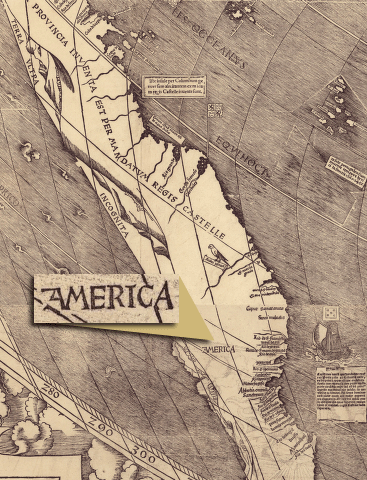 The name America (applied to present-day Brazil) appeared for what is believed the first time on Martin Waldseemüller’s 1507 world map, known as the Baptismal Certificate of the New World, and also America’s Birth Certificate.
The name America (applied to present-day Brazil) appeared for what is believed the first time on Martin Waldseemüller’s 1507 world map, known as the Baptismal Certificate of the New World, and also America’s Birth Certificate.
Amerigo Vespucci From Wikipedia, the free encyclopedia

Amerigo Vespucci
Posthumous portrait in the Giovio Series at the Uffizi in Florence, attributed to Cristofano dell’Altissimo, c. 1568.
|
|
| Born | 9 March 1454
Florence, Republic of Florence (In modern day Italy)
|
|---|---|
| Died | 22 February 1512 (aged 57)
Seville, Crown of Castile (In modern day Spain)
|
| Other names | Américo Vespucio (Spanish) Americus Vespucius (Latin) Américo Vespúcio (Portuguese) Alberigo Vespucci |
| Occupation | Merchant, explorer, cartographer |
| Known for | Demonstrating to Europeans that the New World was not Asia but a previously unknown fourth continent[a] |
Amerigo Vespucci (/vɛˈspuːtʃi/;[1] Italian: [ameˈriːɡo veˈsputtʃi]; 9 March 1454 – 22 February 1512) was an Italian merchant, explorer, and navigator from the Republic of Florence (modern Italy), from whose name the terms America and Americas are derived.
Between 1497 and 1504, Vespucci participated in at least two voyages of the Age of Discovery, first on behalf of Spain (1499–1500) and then for Portugal (1501–1502). In 1503 and 1505, two booklets were published under his name, containing colourful descriptions of these explorations and other alleged voyages. Both publications were extremely popular and widely read across much of Europe. Although historians still dispute the authorship and veracity of these accounts, at the time they were instrumental in raising awareness of the new discoveries and enhancing the reputation of Vespucci as an explorer and navigator.
Vespucci claimed to have understood, back in 1501 during his Portuguese expedition, that Brazil was part of a different continent, which he called the New World. The claim inspired cartographer Martin Waldseemüller to recognize Vespucci’s accomplishments in 1507 by applying the Latinized form America for the first time to a map showing the New World. Other cartographers followed suit, and by 1532 the name America was permanently affixed to the newly discovered continents.
It is unknown whether Vespucci was ever aware of these honours. In 1505, he was made a citizen of Castile by royal decree and in 1508, he was appointed to the newly created position of chief navigator for Spain’s Casa de Contratación (House of Trade) in Seville, a post he held until his death in 1512.
spacer
Paradise lust: the man who sexed up America
He had two continents named after himself and thrilled Europe with the salacious tales of what he saw there. But, 500 years on, can we trust Amerigo Vespucci’s accounts? Peter Popham discovers the full story
Christopher Columbus didn’t know where he was going when he set out and he didn’t know where he had been when he got back. But was Amerigo Vespucci, who died 500 years ago today and after whom America was named, any better informed?

A person who has not one but two continents named after himself is likely to attract his share of jealousy. The Florentine mathematician and navigator who crossed the Atlantic a few years after Columbus, making landfall in what are now Venezuela and Brazil and reaching almost as far south as Patagonia, has been called many names over the years, a deliberate liar, a “faker”, a “false pickle-dealer” and much else.
The son of a notary who expanded his client base to include the city’s ruling elite, Vespucci was born in 1454, and in his youth he was close to the men and women who made Florence the flower of the Renaissance. Vespucci was swept up in the hectic scholarly atmosphere of the city, the rapidly evolving knowledge of geometry, mathematics, philosophy, medicine, astronomy and astrology, and became a close friend of a cousin of Lorenzo de’Medici.
The studies were by no means only of theoretical interest. With the fall of the Khans in China and the conversion of the Mongols who ruled Persia to Islam, Marco Polo’s land route to the Far East was blocked. Thanks to Polo all Europe knew about the fabulous riches of the Orient, and now the Renaissance men of Florence and elsewhere dreamt of reaching them by sea. Vespucci’s contemporary in the city, the polymath (a person of wide-ranging knowledge or learning.) Paolo dal Pozzo Toscanelli, wrote to the King of Portugal in June 1474, dangling before him visions of “these very fertile lands with every type of spice and gems,”(spice and gems very crucial to working magic) of palaces covered with solid gold (gold is primary to MAGI) where philosophy and astrology, arts and inventions flourish,” (note the focus on those subjects most important to DRUIDs/MAGI) and insisting that a sea passage to the East was a certainty. “I send Your Majesty a map drawn by my own hand [indicating] the islands from which the journey to the East must commence…”
It was all of course a tremendous bluff: these men knew the world was round circular, but had only the haziest idea what lay on the other side of it. But the challenge of the unknown was too much to resist: in 1491, the year before Columbus made landfall in “the Indies”, Vespucci left Florence and headed for Seville. Supporting himself as a supplier to departing ships – hence the “pickle-dealer” slur hurled at him centuries later by Ralph Waldo Emerson – he immersed himself in maps and charts and speculation. He left on his first voyage on 10 May 1497, taken on as a specialist in the primitive art of navigation.
He was not a natural sailor. Writing to Lorenzo de’Medici, he moaned about “the risks of shipwreck, the innumerable physical deprivations, the permanent anguish that afflicted our spirits… we were prey to such terrible fear that we gave up every hope of surviving.” But when everything was as bad as it could get, “In the midst of this terrible tempest… it pleased the Almighty to show us the continent, new earth and an unknown world.”
These were the words that, once set in type, galvanised Europe. Vespucci knew the geographical works of Ptolemy and had spent years steeped in maps and geographical speculation. For him the coast of modern Venezuela and Brazil where his expedition landed had nothing in common with the zones described by explorers of the Orient. Instead this was something far more fascinating – an unimagined world.
“Surely,” he wrote, “if the terrestrial paradise be in any part of this earth, I esteem that it is not far from these parts.” In his description, this New World is made up of extremes. On the one hand, the people he encounters are living in a dream-like state of bliss: with no metals except gold, no clothes, no signs of age, few diseases, no government, no religion, no trade. In a land rich in animals and plants, colours and fragrances, free from the stain of civilisation, “they live 150 years and rarely fall ill”.
Vespucci’s sensational description inspired an early etching of the Florentine’s first encounter with an American: the explorer and the naked, voluptuous and very pale woman lock eyes; the woman is in the act of clambering off a hammock and moving in his direction. Meanwhile, on a nearby hillock, a woman is roasting the lower half of a human body over a fire.
The wild and fantastic nature of Vespucci’s descriptions raises the question of how reliable any of his observations are – but then vast doubt surrounds almost everything about his adventures. We don’t know how many voyages he undertook; his authorship of some of the accounts is questionable; and it is not even universally accepted that he identified South America for what it was, a new continent.
That honour may more rightly lie with the man who immortalised his name: a German geographer called Martin Waldseemüller, a member of an amateur learned society. In the society’s survey of world geography published in 1505 they included one of Vespucci’s accounts, and a world map with the new, southern continent labelled “America” – the first time the coinage had been used, in honour of “its discoverer, a man of great ability”.
The geographer later changed his mind about Vespucci’s worthiness and wanted to change the continent’s name. But by then the Florentine’s tales of sex and cannibalism in paradise had made him world famous. And the name stuck.
AMERICA, n. {from Amerigo Vespucci, a Florentine, who PRETENDED to have first discovered the western continent} (Noah Webster’s 1828 Dictionary of the English Language).Rare Waldseemüller’s Map Sells for Record $1M at Auction

Amerigo Vespucci was a moneychanger from the Florentine banking House of Medici. Banking was considered the lowest profession because of the unseemly practice of money lending at interest or usury. Vespucci is derived from the Italian word for WASP—a nasty stinging insect.
Vespucci arrived in Seville, Spain in 1491 and worked as a clerk for the banking firm of Juanoto Beraldi, branch office of the Medici banking House in Florence.
He is never heard of again in any of the historical records until 1503 when he wrote a letter to his boss in Florence and called the newly discovered lands a MUNDUS NOVUS or NEW WORLD.
In this Mundus Novus letter, Vespucci claimed to have made 4 voyages to this New World. It is not very hard to PROVE that the so-called voyages were a total fantasy and mere fiction.
 Waldseemuller’s map came from the last voyage of John Cabot!!
Waldseemuller’s map came from the last voyage of John Cabot!!
This map is a damning indictment of Portugal and the Vatican because the first question that arises is: At that time (1507), where did they get the geographical information that the western continent was a separate continent from Asia?
Certainly not from Columbus because he was so inept as a sailor that he sank his own ship the Santa Maria on his first voyage!!
The Pinzón brothers, Martin and Vincent, were expert sailors when following someone else’s map but Martin was killed by Columbus after they returned to Spain in March, 1493.
Ferdinand Magellan did not start his around the world voyage until 1519 —12 years after the publication of the Waldseemuller map.
The expert mariner was John Cabot!!
Giovanni Caboto (John Cabot) was an expert mariner who was DETERMINED to get to China. On his 3rd voyage in 1497 he mapped the coast from Canada to Florida. On that voyage he left Bristol around May 20, 1497, and returned in August, 1497. Only 3 months to complete a voyage of at least 10,000 miles. That is expert sailing . . . even by today’s standards….Here is a report from the Milanese ambassador to England:
“Perhaps amid the numerous occupations of your Excellency, it may not weary you to hear how his Majesty here has gained a part of Asia, without a stroke of the sword. There is in this Kingdom a man of the people, Messer Zoane Caboto by name, of kindly wit and a most expert mariner. Having observed that the sovereigns first of Portugal and then of Spain had occupied unknown islands, he decided to make a similar acquisition for his Majesty. After obtaining patents that the effective ownership of what he might find should be his, though reserving the rights of the Crown, he committed himself to fortune in a little ship, with eighteen persons. He started from Bristol, a port on the west of this kingdom, passed Ireland, which is still further west, and then bore towards the north, in order to sail to the east, leaving the north on his right hand after some days. After having wandered for some time he at length arrived at the mainland, where he hoisted the royal standard, and took possession for the king here; and after taking certain tokens he returned….
“This Messer Zoane, as a foreigner and a poor man, would not have obtained credence, had it not been that his companions, who are practically all English and from Bristol, testified that he spoke the truth. This Messer Zoane has the description of the world in a map, and also in a solid sphere, which he has made, and shows where he has been.
“But Messer Zoane has his mind set upon even greater things, because he proposes to keep along the coast from the place at which he touched, more and more towards the east, until he reaches an island which he calls Japan [Cipango in original], situated in the equinoctial region, where he believes that all the spices of the world have their origin, as well as the jewels.” (Letter to the Duke of Milan).
On his 4th and last voyage in 1498, he sailed with 5 ships and provisions for a long voyage of discovery. John Cabot MUST have sailed completely around the New World and far into the Pacific ocean. If he had continued to China he would have arrived safely back in England. It so happened that a Spanish armada led by pirate Alonso de Hojeda killed him and took his maps back to Spain!! That is how Vespucci got a hold of them and ended up with his foul name on the map of the New World.
Vespucci stole John Cabot’s geographical information!!

This is one of the first published maps showing the New World as a separate continent from Asia. It has the name America written on the New World.
At that time, only one man could have known the geographical extent of the western continent and that was JOHN CABOT.
Columbus did not even reach the mainland until his 3rd voyage in 1498.
On his 4th voyage, Cabot was determined to reach Asia. His expedition was ambushed by Portuguese pirate Jasper Corte-Real and Spanish pirate Alonso de Hojeda.
The Dates of the 4 so-called voyages of Amerigo Vespucci
| Voyages |
Date
|
Flag
|
|
1
|
May 10, 1497, to October 15, 1498 |
Spanish
|
|
2
|
May 16, 1499, to September 8, 1500 |
Spanish
|
|
3
|
May 10, 1501, to October 15, 1502 |
Portuguese
|
|
4
|
May 10, 1503, to June 18, 1504 |
Portuguese
|
There is no mention of the so-called voyages of Vespucci in the Portuguese archives. Here is a quote from a Portuguese historian:
“NEITHER in the original chancelleries (Chancellarias originaes) of the king Don Manuel, from 1495 to 1503, inclusive, nor in the 82,902 documents of the chronological-records, (Corpo chronologico,) or the 6,095 of the chest-records, (Corpo das gavetas,) nor yet in the numerous letters missive from kings, princes, and other personages,—letters deposited in the royal archives, have we found the slightest mention of the name of Vespucius, or of those of Giuliano del Giocondo and Bartolomeo del Giocondo” (Viscount Santarem, Researches Respecting Americus Vespucius and His Voyages, p.13).
Spain and Portugal were RIVALS in carving up the New World. Each country jealously guarded all geographical information and many times they were ready to go to war over their rival claims.
Pope Borgia prohibited ANYBODY but Spanish from going to the New World!!
There is NO RECORD of Amerigo Vespucci ever obtaining a LICENSE to visit the New World…. He did not become a Spanish subject until 1505, when he married a woman named Maria Cereso. Here is an excerpt from the Bull of Borgia prohibiting anybody from going to the New World without a license:
“Furthermore, under penalty of excommunication late sententie to be incurred ipso facto, should anyone thus contravene, we strictly forbid all persons of whatsoever rank, even imperial and royal, or of whatsoever estate, degree, order, or condition, to dare, without your special permit or that of your aforesaid heirs and successors, to go for the purpose of trade or any other reason to the islands or mainlands, found and to be found, discovered and to be discovered, towards the west and south, by drawing and establishing a line from the Arctic pole to the Antarctic pole, no matter whether the mainlands and islands, found and to be found, lie in the direction of India or toward any other quarter whatsoever, the said line to be distant one hundred leagues towards the west and south, as is aforesaid, from any of the islands commonly known as the Azores and Cape Verde; apostolic constitutions and ordinances and other decrees whatsoever to the contrary notwithstanding.” (Inter Caetera Bull ).
Florentine prophet rebuked the crimes of the Borgias!!
God raised up a mighty prophet in Florence named Saint Girolamo Savonarola. He was a Dominican monk and the forerunner of Saint Martin Luther. He was the morning star of the Reformation. In 1498, he called for a Council of the Congregation in order to DEPOSE Pope Borgia. This was the last straw and led to his arrest, torture and then death by burning.

Saint Girolamo Savonarola was a Florentine Dominican monk who was HORRIFIED by the scandalous conduct of Pope Borgia and his many bastard children. He was the forerunner of Saint Martin Luther, but unlike Saint Martin, the only “bible” available to him was the BLUNT SWORD of the corrupt Latin Vulgate Version of Jerome. He was a spellbinder and great crowds flocked to hear his sermons.
The blessed Reformation would have commenced in Florence, and not in Wittenberg, but for the arrest and murder of Saint Girolamo Savonarola.
He denounced in no uncertain terms Pope Borgia, Lorenzo de Medici, and the corrupt lives of the Florentines.
By his preaching he was able to clean up FILTHY Florence, and the people brought all the lewd pictures, playing cards, dice and had a great Bonfire of the Vanities.
spacer
Meaning and Origin of: Borg: Name Variations: Borc and Borge
|
| borgi (Icelandic): meaning, translation – WordSense Noun borgi (fem.) ( plural borgi, or borgiuri) debt duty Synonyms debt: hreu See also mprumut sartsinã dat borgi ( Icelandic) Verb borgi Dictionary entries Entries where “borgi” occurs: debt: …to perform for another Arabic: دَيْن Armenian: պարտք Aromanian: borgi (fem.), hreu (neut.) Bashkir: бурыс… |
| Borgia History, Family Crest & Coats of Arms – HouseOfNames The place name Borja is itself derived from the Arabic word “burdz,” which means “tower” and is an indication that in the town of Borja there were several towers or a prominent tower. Early Origins of the Borgia family The surname Borgia was first found in Zaragoza, in the region of Aragon in Spain. |
|
Here are all the possible meanings and translations of the word Borgi. Did you actually mean borgia or borges? How to pronounce Borgi? David US English Zira US English How to say Borgi in sign language? Numerology Chaldean Numerology
|
spacer
Horn Fountain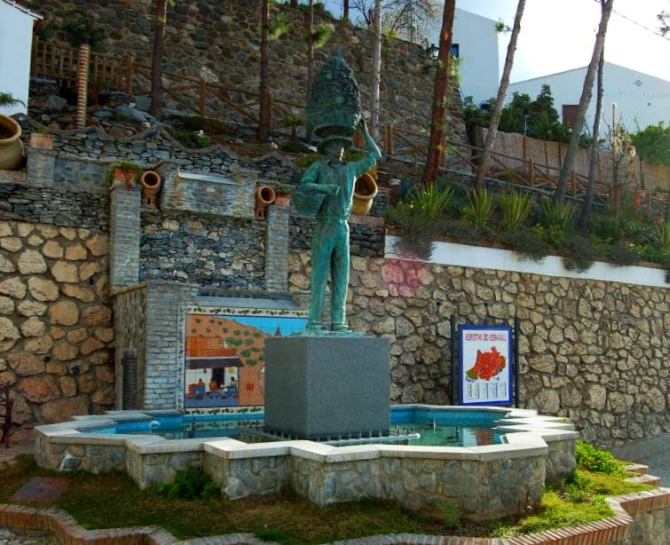 Axarquia Guide >> El Borge Guide >> Fuente del Cuerno El Borge is a Spanish municipality in the province of Málaga, Andalusia, located in the Axarquía region. By road it is located just 36 kilometers from Malaga and 567 km from Madrid. In 2008 it has a population of 1,048 inhabitants; in 2000 it had 1,021 (data from the INE [1]). The Arab origin of the population is explained by the etymology of the name Al-Borg; but in reality little is known about the history of this municipality. It is known from the chronicles of that time that a community of Moors lived there who strongly resisted the Christian occupation. What can I tell you about Fuente del Cuerno? Arabic fountain that has been recently restored, is located in the street of the same name. In Wikipedia you can also know more about El Borge Information in Wikipedia about El Borge. If you want to know more about the El Borge Guide, you can visit the website of the El Borge town hall More information about El Borge Everything you need to know about El
|
 |
 |
 |
 |
Borges Family Crest / Coat of Arms |
Borges família heráldica-genealogia brasão Borges |
File:Borgesb.png |
Brasão dos Borges. Borges Family Coat-of-arms. | Heraldry, Animals, Rooster |
spacer
Last name: BorgesFile: 602850 Type: Heraldic Dossiers
Text language: Portuguese
Nobility: Knights – Lords
Nobles in: Portugal ( Portugal )
Heraldic dossiers:
|
Borges Italian English Spanish Portuguese Deutsch  |
spacerspacerIt was his determination to get rid of Pope Alexander VI that led to his martyrdom:
“He was resolved to make a final effort to procure the assembly of a Council, appeal to it in his own defence, denounce the abominable life and crimes of Rodrigo Borgia, and declare his election void as having been obtained by simony (the buying or selling of ecclesiastical privileges, for example pardons or benefices). He would also prove that the Pope was a heretic and an unbeliever, that his life was unworthy of a Christian, and that he was accordingly the main source all the evils lacerating the Church. Nor would there be any lack of documents, both public and private, to support these charges. Thus, the necessity of reforming the Church would be proved, and the enterprise finally begun. It was in allusion to this, that he had so frequently repeated the phrase: one day we will give a turn to the key; we will cry aloud: Lazare, veni foras (Lazarus, come away), and similar expressions. That day was now come “(Villari, Life & Times of Girolamo Savonarola, pp. 642-643).
Vespucci’s uncle was chief opponent of Saint Girolamo!!
It wasn’t by accident that the Vespucci family were named WASPS. Guidantonio Vespucci (uncle of Amerigo) was the chief opponent of Saint Girolamo, and the enforcer for Pope Alexander VI in Florence. Guidantonio was also one of the chief influences on Amerigo as he was growing up. He presided at the trial, torture and burning of Saint Girolamo:
“Messer Guidantonio Vespucci, spokesman for the bench of the doctors of the law, who in the Pratica of the 14th of March had been the chief of Savonarola’s opponents, was the first to rise to his feet. He instantly proposed: “That Frà Gerolamo rshould be privately examined (tortured) by competent persons, so that when the trial was concluded, only such portions of it as their Excellencies thought fit need be made known to the public. That it would not be expedient to send the Friar to Rome, but merely to inform the Pope that he would be kept in safe custody.”(Villari, Life & Times of Girolamo Savonarola, p. 697).
Amerigo Vespucci was substituted for Richard Amerike!!
John Cabot’s Bristol paymaster was named Richard Amerike. Merrick is a common name in the U.S. and the name comes from the Merricks of Bristol, England. When Vespucci saw the name Richard Amerike, either on a map of the New World or among the papers of John Cabot, he noticed the similarity of names. Right then and there his devilish mind began to concoct a scheme to supplant Richard Amerike and have the New World named after himself!!
Vital Links
Pope Borgia BURNED Italian Reformer Girolamo Savonarola!!
Letter to the Duke of Milan describing the discovery of the New World by John Cabot!!
Brion, Marcel. The Medici: A Great Florentine Family. (Translated from the French by Gilles & Heather Cremonesi), Crown Publishers, New York, 1969.
Cloudas, Ivan. The Borgias. (Translated from the French by Gilda Roberts), Franklin Watts, New York, 1989.
Hibbert, Christopher. The House of Medici, Its Rise and Fall, William Morrow, New York, 1975.
Lester, Edwards C., The Life and Voyages of Americus Vespucius, New Amsterdam Book Co., New York 1903.Pohl, Frederick J., Amerigo Vespucci Pilot Major, Octogon Books, New York, 1966.
Prescott, William H. History of the Reign of Ferdinand & Isabella, the Catholic. (In 3 volumes). Harper & Brothers, New York, 1854.
Santarem, Viscount, Researches Respecting Americus Vespucius and His Voyages. Charles C. Little & James Brown, Boston, 1850.
Villari, Professor Pasquale. Life and Times of Girolamo Savonarola. (Translated from the Italian by Linda Villari), London, 1888.
Waldseemüller, Martin. Cosmographiae Introductio (Introduction to Cosmography)...to Which are Added the Four Voyages of Amerigo Vespucci. (Translated by Joseph Fischer & Franz von Wieser), University Microfilm, 1966.
Zweig, Stefan. Amerigo: A Comedy of Errors in History. (Translated from the German by Andrew St. James), Viking Press, New York, 1942.
Copyright © 2007 by Niall Kilkenny
spacer
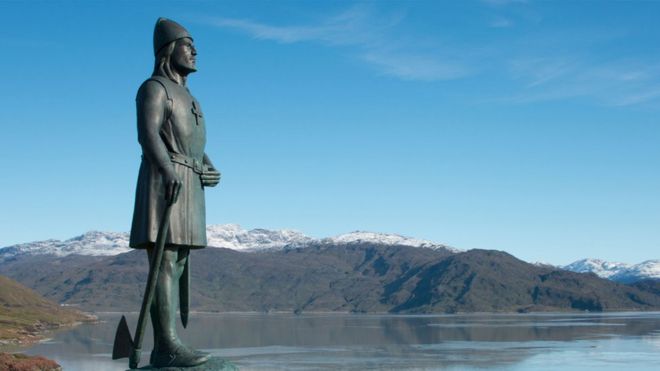 Image copyrightALAMY
Image copyrightALAMYAfter a long hike across boggy ground and through thick pine forests, clutching pepper spray to protect against bear attacks, Sarah Parcak and her small team of archaeologists stood on an exposed, wind-blasted headland in North America.
Exhausted but happy, they had been led to Point Rosee in Newfoundland by the most high-tech weaponry in the modern archaeological arsenal – satellite data captured 383 miles (600km) above the Earth. But once here they were back to using trowels and brushes. I joined them to see how this powerful combination of new and old allowed them to make what could be a seismic discovery.
We were here on the trail of one of the greatest maritime cultures of all time. We were here inspired by ancient chronicles which many have written off as fairy stories. We were here looking for Vikings.

spacer

Visit the webpage to watch the video: CLICK HERE

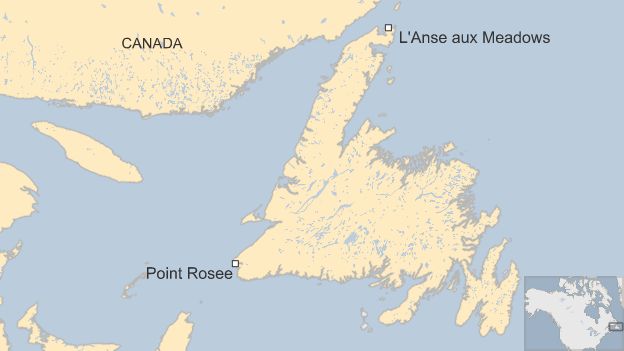
In about 800AD Britain felt the fury of these men from the north. Portmahomack was one of Scotland’s most prosperous and important communities. On a protected bay in Easter Ross, on the edge of the Highlands, it was well placed as a waypoint for merchants, travellers and pilgrims moving along the east coast.
Recent excavations have given us a picture of a wealthy monastery at its heart. Scriptures were copied on to carefully prepared animal skin parchment by monks, skilled craftsmen created beautiful, jewel-encrusted religious ornaments, sculptors carved intricate Celtic crosses. (as the Knights Templar Cross and the DRUID cross) Trade was the source of these riches, the sea brought wealth, but the sea also brought destruction.
Archaeologists have revealed that Portmahomack was suddenly and utterly destroyed. They found smashed fragments of sculptures mingled with the ashes of torched buildings. The settlement was wiped out. It is impossible to be certain but historians now think the most likely explanation is that it was attacked and looted. When I visited, a couple of months before the trip to Point Rosee, I held a piece of skull in my hand, presumably from a monk.
 Image copyrightDAN SNOW
Image copyrightDAN SNOWIt had been shattered by a mighty blow, the sword’s blade left a deep gouge that makes the cause of death clear. Who were these men who slaughtered God’s servants and annihilated one of the oldest Christian sites in Britain? Almost certainly they were men who cared nothing for the Christian God, men who came in ships from the north and west, men who sought gold: Vikings.
The attack on Portmahomack is the only Viking raid in Britain for which we have archaeological evidence. Others, such as the attack on Lindisfarne at about the same time, echo only through the reports recorded in chronicles. Together these two violent raids mark the start of an era of attacks from across the North Sea. The Vikings or Norse exploded out of Sweden, Denmark and Norway, using hugely sophisticated navigational skills and shipbuilding technology as they pushed ever further into the wider world.
Vikings conquered Normandy in France – the land of the Northmen – even parts of Italy and the Levant. They also founded Dublin, made deep inroads into England and island-hopped across the North Atlantic. Orkney, Shetland, Fair Isle and Iceland.
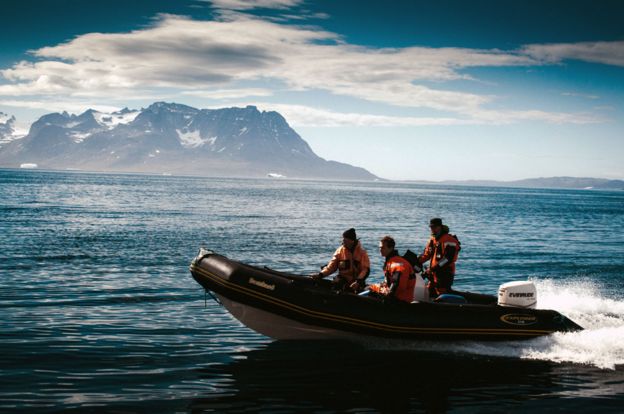 Image copyrightBBC/FREDDIE CLARE
Image copyrightBBC/FREDDIE CLAREThey even crossed to Greenland, where I visited stunning Viking sites on the coast, dodging icebergs to get ashore. But perhaps their greatest achievement is the one shrouded in the most mystery. Did they get to North America? If so, was it a fleeting visit or did they colonise that distant coast too, centuries before Christopher Columbus?
The descendants of the Vikings left sagas – beautiful works of literature in which fact and fiction are often poetically intermixed. They clearly state that the intrepid Leif Erikson led an expedition to the east coast of North America. They describe good harbours, and an abundance of natural resources. One of the most fascinating mysteries in history is whether these can be believed.
Find out more
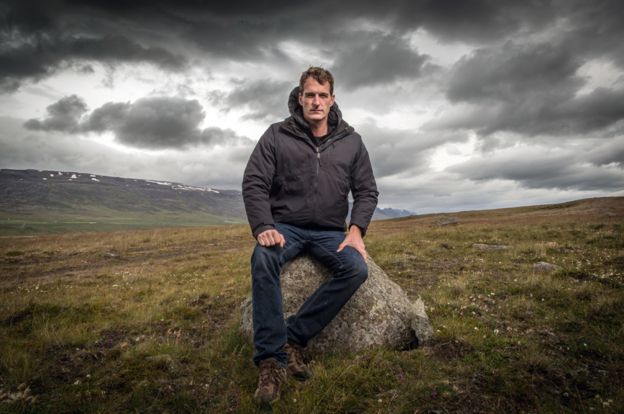 Image copyrightBBC/FREDDIE CLARE
Image copyrightBBC/FREDDIE CLAREIn The Vikings Uncovered Dan Snow tracks their expansion west, first as raiders and then as settlers and traders. He travels through Britain, to Iceland, Greenland and Canada to see what could be the most westerly Viking settlement ever discovered. The programme will be on BBC One on Monday 4 April at 20:30.
In 1960, a site on the very northernmost tip of Newfoundland in Canada, L’Anse aux Meadows, was investigated and archaeologists were convinced that it was a Viking settlement. The world woke up to the fact that the Vikings had reached North America before any other Europeans. But no other site has been identified, the search for Viking America stalled. Until now.
Sarah Parcak uses satellite imagery to look for irregularities in the soil, potentially caused by man-made structures which lie beneath. She has used this technique to find ancient sites in Egypt and a few years ago she scoured the Roman Empire where she identified the site of the great lighthouse at Portus near Rome and several other buildings, from a fort in Tunisia to ramparts in Romania. Last year, she decided to search for the Vikings.
It wasn’t easy. They travelled light and left nothing behind. No massive stone theatres for them. They voyaged in longships with a strong oak keel, and thin overlapping planks fanning out to form the iconic, graceful hull – the gaps between the planks stuffed with animal hair and tar. The rudder was fixed on with a twisted birch sapling. Sails spun from wool. Food was pickled herring, lamb smoked using reindeer droppings, fermented salmon. Almost everything on a Viking ship would get recycled or rot away. But they did leave a trace, and Parcak’s team were determined to pick it up, however faint.
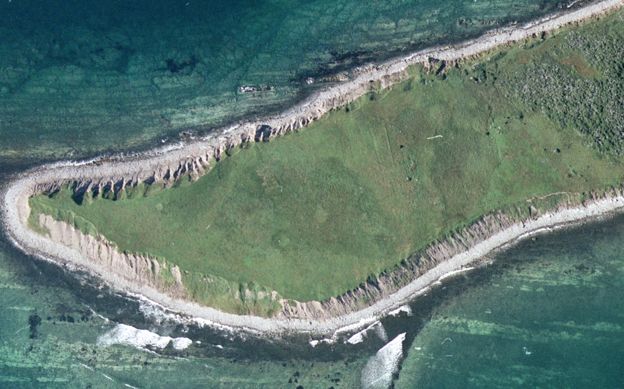 Image copyrightIMAGE © 2016 DIGITALGLOBE INC
Image copyrightIMAGE © 2016 DIGITALGLOBE INCThey scanned satellite pictures from across the east coast of America. Several sites appeared worth following up, but they had to decide on one for a dig. In the end they opted for a headland, almost the very western tip of Newfoundland, 400 miles further south and west than the only known Viking site in North America.
It overlooked two bays, offering protection for ships from any wind direction. Parcak saw oddities in the soil that stood out – patterns and discolourations that suggested artificial, man-made structures, possibly even Viking longhouses, once stood there.
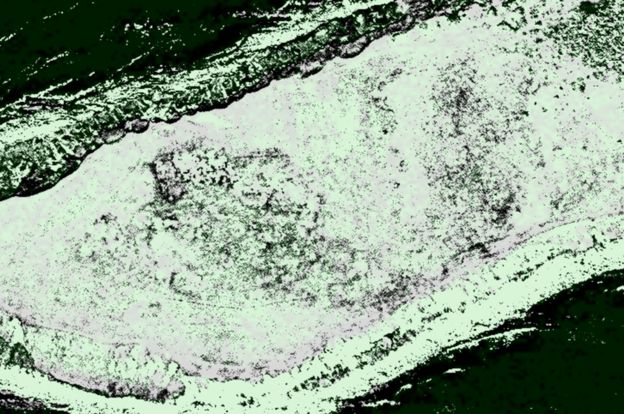 Image copyrightIMAGE © 2016 DIGITALGLOBE INC
Image copyrightIMAGE © 2016 DIGITALGLOBE INCIt was time to leave the lab, and head out into the field. For a couple of weeks Parcak led the team as they carefully probed the ground that she had first spotted thanks to a satellite hundreds of miles away in space.
Newfoundland’s climate is as brutal as ours in the British Isles with hail, gales, sweltering sun and driving rain. Exploratory trenches were flooded, equipment blew away, but they toughed it out and found something tantalising.
Months before, in her lab, Sarah had shown me an image that she thought might be the site of burning or metalwork. Sure enough, when she started to dig on the exact spot, she found something. Something that might prove to be a breakthrough. Carefully peeling back the layers of earth, she found what seemed to be a hearth.
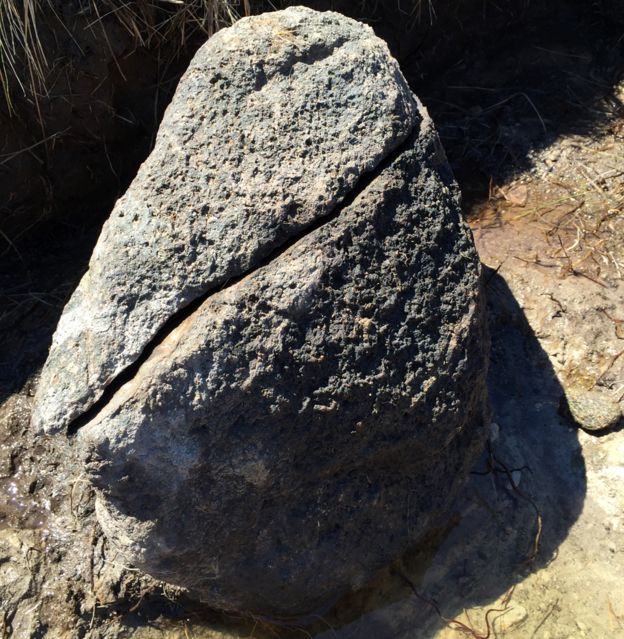 Image copyrightDAN SNOW
Image copyrightDAN SNOWA blackened rock testified to intense temperatures. Beneath it were piles of charcoal mixed with cooked bog iron – an iron deposit that needs to be baked to drive off impurities and allow the iron to be extracted for smelting. Surrounding the hearth appeared to be a turf wall of the kind built by Viking settlers across the North Atlantic.
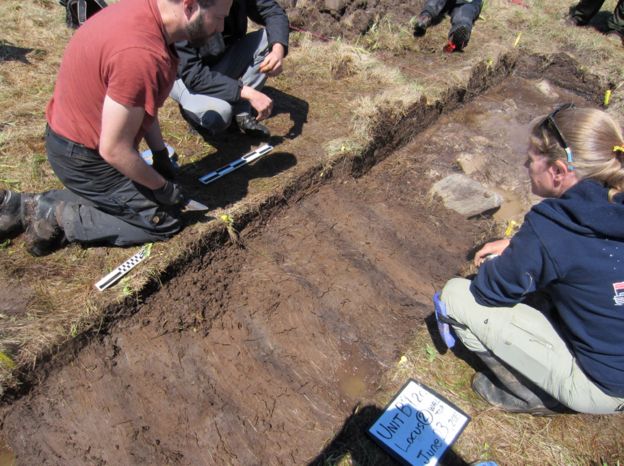 Image copyrightGREG MUMFORD
Image copyrightGREG MUMFORD“I am absolutely thrilled,” says Parcak. “Typically in archaeology, you only ever get to write a footnote in the history books, but what we seem to have at Point Rosee may be the beginning of an entirely new chapter.
“This new site could unravel more secrets about the Vikings, whether they were the first Europeans to ‘occupy’ briefly in North America, and reveal that the Vikings dared to explore much further into the New World than we ever thought.”
She immediately checked that there could be no other explanation for these deposits. Newfoundland historian Olaf Janzen was certain, no other groups of settlers roasted bog iron in Newfoundland. Nothing has been proven yet, but it looks like Parcak might have found evidence for Viking exploration in North America that goes much further than just that one site discovered in the 60s.
This find “has the potential to change history” says Douglas Bolender, an expert on Viking settlement who has spent 15 years tracking the Vikings across the north Atlantic. “Right now the simplest answer is that it looks like a small activity area, maybe connected to a larger farm that is Norse.” He is excited and can’t wait to see what further excavation reveals. He’s hoping that seeds or other organic matter that can be carbon dated will be unearthed.
If Parcak has found evidence of another Viking site, it will ignite a new search for Viking settlements across eastern Canada and New England, perhaps as far south as New York and even beyond. Technology has unlocked long forgotten stories from our past, and that technology is getting ever more sophisticated. For those of us who are fascinated by the travels of the intrepid Norsemen, the next few years will provide ever more inspiration.
The Vikings Uncovered is on BBC One on Monday 4 April at 20:30
Go berserk with iWonder
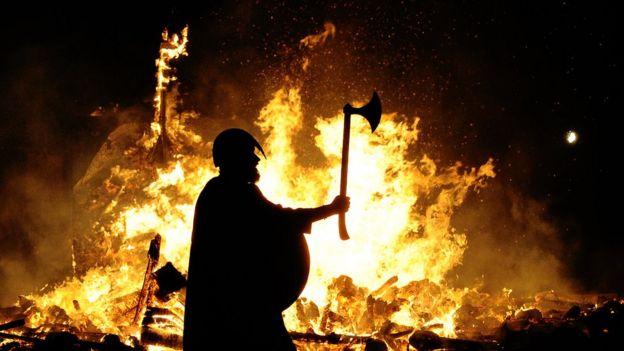 Image copyrightGETTY IMAGES
Image copyrightGETTY IMAGESVikings warriors were a fierce bunch, trained in archery, spear-throwing and swordplay from the age of 10. The most fanatical warriors were called “berserkers”.
Could you be a Viking Warrior?
spacer
spacer
This next video is included here to bring evidence that first of all that there were obviously people populating the ENTIRE earth throughout time. (Since God dispersed them through the ENTIRE EARTH.) Second, that all peoples have been corrupted by the same evil influences, and developed the same evil practices and beliefs. Third, that it is likely that the MAGI (by different names amongst different people) are the main carriers of this corruption.
spacer
spacer
YAHUAH CREATED THE HEAVENS & THE EARTH
A Grand Deception for What?
Posted on
A Biblical Flat Earth Documentary – The Global Lie explores the truth about our world and exposes the satanic lies that have been in motion for over 500 years. A shocking discovery that will change the way you think about our past, present, and future. The world is not what you think it is.
The position of flying through space while orbiting the sun, headed to nowhere exactly, is what really devalues and distracts from YAHUAH’s creation and human life. The earth is reduced to happenstance and insignificance in light of the unending universe of space, planets, and stars. Humanity appears to be a cosmic accident rather than a beautifully designed creation of YAHUAH.
Note: “The Principle” featured in this film does not believe in Flat Earth Theory, but their movie really does show how much we’ve been lied to by so-called “modern science”.
spacer
By Steve Thomason
This PowerPoint presentation (and .zip image pack) offers a visual introduction to the basic ancient cosmology. It is important to understand the ancient worldview in order to fully grasp the language and context of God’s Promises to Abraham’s family. The temptation toward power struggles and violence in the ancient world are still present today. May we learn to hear God’s Promises, through Jesus Christ, clearly in our present situation.
This is a labor of love. You can purchase this for free or pay as much as you want as a donation to the ongoing production of these visual materials. Feel free to use this presentation for your preaching, teaching, or personal study.
Learn more at https://www.stevethomason.net/bible
spacer
ANCIENT COSMOLOGY
All Ancient Cosmology Everywhere Was a Stationary, Enclosed, Plane\

As neighbors, the ancient Hebrews had the Egyptians to the southwest and the Babylonians to the northeast. ALL three civilizations had flat earth cosmologies. The Biblical cosmology closely parallels the Sumero-Babylonian cosmology, and it may also draw upon Egyptian cosmology.
The Babylonian cosmology was shaped like a modern domed stadium. The Babylonians considered the earth essentially flat, with a continental mass surrounded by ocean. The vault of the sky was a physical object resting upon the ocean’s waters (and perhaps also upon pillars). Sweet (salt-free) waters below the earth sometimes manifest themselves as springs. The Egyptian cosmology was also enclosed, but it was rectangular instead of round. Indeed, it was shaped much like an old-fashioned steamer trunk. (The Egyptians pictured the goddess Nut stretched across the sky as the enclosing dome.) And here are pictures of what major ancient civilizations had thought about the earth and the cosmology:
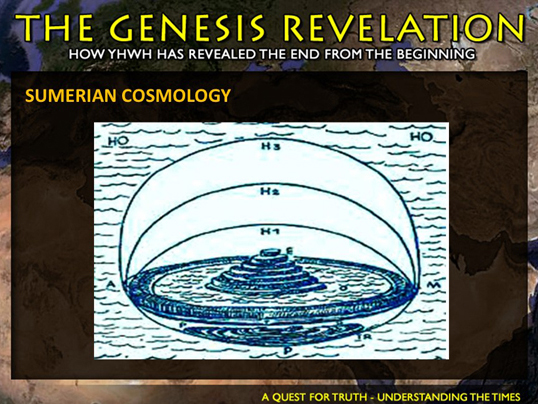

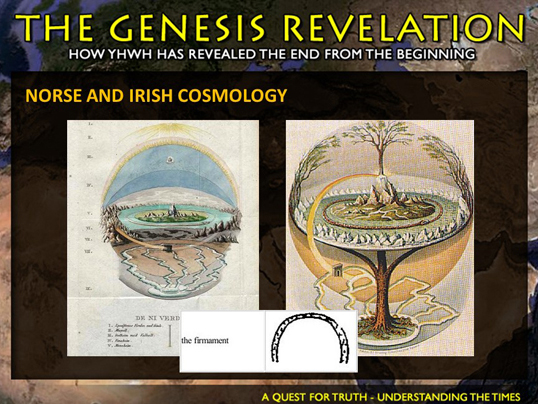 spacer
spacer

Hebrew Cosmology

The Tabernacle of Yashar’el in the Wilderness. YAHUAH created the stationary, enclosed earth on a plane, for Man to dwell in. Then He commanded Yashar’el to create an enclosed, circular tent on flat ground for Him to dwell in.
People from every nation of the world might be familiar with the story of Yashar’el’s wilderness journey. According to the Scriptures, the Hebrews built the great Tabernacle of YAHUAH in the wilderness, following the Egyptian Exodus so that YAHUAH might dwell among them. A conventional life-size model (Timna Park, Is-ra-el) of that Tabernacle is shown in the image below:
If you believe that you live on a spinning globe, think again. The spinning globe earth paradigm is a 500 years and running conspiracy perpetrated by the Jesuits, the Vatican, Kabbalahists, and the Freemasons. There is no observable curvature on earth and motion has never once been detected. NASA has never been passed “low earth orbit” and the moon landing was obviously staged. Once you understand the consequences of living on a stationary, enclosed, rectangular, plane, you’ll start to see why this information and knowledge is so important. Note, we are not the Flat Earth Society. They are controlled opposition to keep people away from flat earth Truth. This is a website with some of the best flat earth videos, documents, and documentaries on the internet. Unlike the Space & Universe channel with their phoney ISS live feed of earth from space, this website is jam-packed full of facts that provide flat earth proof. The flat earth is not a theory and it has not been debunked. Though we are forced to theorize on what an accurate map of the earth may look like, at least we don’t make wild claims such as earth is spinning ball, heliocentricism, gravity, and everything came from nothing.
Earth is a stationary, enclosed, rectangular plane, set on pillars just as it appears and just like our senses have always told us. NASA lies and is spearheading the campaign to deceive you and the rest of the world. Space X and other “aerospace” companies are a part of the deception, at least the owners and employees at the highest echelons. To clarify, not every scientist, pilot, school teacher or NASA employee is in on this ordeal. Don’t let these Occultists, fake space programs, and mainstream Scientism fool you. Think critically, logically, and do your own re-search before blindly believing that you live on a spinning, pear-shaped, oblate spheroid flying through an infinite black void of darkness and chaos that has never been proven.
This post is intended for the viewer to start asking questions!
Wake up, look up, and let your quest for Truth begin!
All credit is due to the realist community!
Thank you so much for all the research and hard work!
All glory and praise to EL ELYON YAHUAH ELOHIYM YAHUSHA HAMASHIACH!
Amein, and shalom!

spacer
33 degree Luciferian Mason Karl Marx (nee Moses Mordechai Levy) was a secret High Priests of Satan and was financed by Edomite “Cult of Saturn” Banker Nathan Rothschild…
Cinco de Mayo Birth of Karl Marx 1818. By some estimates, 1/3 of the world identifies with Marxism in one form or another. China President Xi Xinping donated a 14ft Bronze Statue of Karl Marx to Trier and gave a May 3 speech praising Marx “Today, we commemorate Marx in order to pay tribute to the greatest thinker in the history of mankind and also to declare our firm belief in the scientific truth of Marxism” that being “God is Dead“.
“When men forget God, tyrants forge their chains” Patrick Henry. Marxist Mao Tse Tung’s “Great Experiment” starved 50M Chinese; Stalin another 50M like all Cryptos they hid Satanism behind a veil, Mao, a graduate of Yale Divinity School, Stalin a Luciferian Freemason and Jesuit. Marx was a Germanic fake Jew; In Gen 9:27 Noah prophesized Germanic descendants of Japheth-Gomer-Ashkenaz would live in Shem’s Tents; “Cryptos” pretend to be Jewish and Christian, hiding their Satanism in private like Marx; Satanism is Freedom from God. Ashkenazi Drumpf, fake Presbyterian Donald Trump used the same “Day of Prayer” (coincidence? NOT!) to announce his and Sodomite/Zionist Mike Pence’ “Faith Based Initiative”; Sodomite, fake Christian George “Gog” Bush Jr also instituted one. Mike is especially dangerous, an initiate of “The Family” with many of Trump’s Cabinet (Sessions, Carson, Coats, DeVoss) and Congress who believe “The men who understood the real message of the New Covenant best were Mao Tse Tung, Adolph Hitler, Joseph Stalin SJ, and Pol Pot”-co-founder Doug Coe
www.theresnothingnew.org/index/The_Family3
Perhaps not coincidentally Hawaii (Water and Breath of Life)
|
|
|
Interesting etymology I found: The etymology of “Hawaii”
In Māori mythology, Hawaiki is the ancestral homeland of the Māori. It also refers to the underworld in many of their stories. The same concept exists in many other Polynesian cultures, including the Tahitians and the Cook Islands Māori. However, in Hawaiian culture, the word has lost that meaning and now refers to the biggest island of Hawaii. Coincidentally, the same thing happened in Sāmoan culture and their version of the word refers to the largest island in Sāmoa. Sources: https://en.wikipedia.org/wiki/Polynesian_languages https://en.wikipedia.org/wiki/Hawaiki https://en.wiktionary.org/wiki/Hawaii#English (Side note: I noticed that Etymonline has a mistake in their etymology of Hawaii. It says it comes from Proto-Polynesian *hawaiki, but that can’t be true because Sāmoan has an /s/ in their version of the word.) |
Mt Kilauea (Spewing) began erupting; the volcanoe is considered by some natives to be the body of the fire goddess Pele who destroys the Earth; Jesus returns to “Destroy those who destroy the Earth” Rev 11:18KJV People who reject Jesus Christ are called “Earth Dwellers” (Rev 13:8) at the start of the Great Tribulation. Marx was perhaps the most influential “Earth Dweller” in history; his theories became the basis of modern Fascism, Nazism, Communism and soon worldwide Socialism; 33 degree Mason, Communist Dictator Mikhail Gorbachev “Socialism will come to America not at the end of a Sword, but through the ballot box“.
33 degree Luciferian Mason Karl Marx (nee Moses Mordechai Levy) was a secret High Priests of Satan who claimed Levite lineage, well like Moses; another fake Levite (nee Antin Lavey) Howard Levy formed the Church of Satan in 1966 in San Francisco, in “Year One Satan“, the same year and city (San Francisco is named after the Franciscans like Pope Francis; Francis=Franks=Free of God) the term “al Qaeda” was invented by Stanford University Islamic studies professor Ibn Sayyid Qutb (Sayyid=descendant of Quyraish tribe, the Satanic Korahite Priests of Num 16 + Qutb=”World Pillar” which was derived from Wahhabism, the Cult of Saudi Arabian Royalty).
Marx melded Copernicus’ Heliocentric Theory with Erasmus Darwin’s Evolution Theory proposed in 1794 in “Zoonomia”, the forerunner of his grandson “Ape Man” Charles’ “Origin of the Species”; the idea Earth was one of billions orbitting its own Star with life Evolving over millions of years drove a nail in the Word of God; 2001: A Space Odyssey illustrates this as does Marx and Satan by Richard Wurmbrand
www.amazon.com/Marx-Satan-Richard-W…/…/0891073795/ref=sr_1_1
Satanism is in essence a Sex Cult of pride and perversion (Ref Lev 18:22; Rom 1:27) based on Pedophilia, Sodomy, Homosexuality, Bestiality, Child Sacrifice, Orgies, illustrated in the movie “Eyes Wide Shut”, foisted on the young in school by the writings of Sigmund Freud, a fellow Sabbattaean (Sabattai Zvi; Sabat=Saturn’s Day) Frankist (Jacob Frank), Satanist like Marx who taught belief in God is repression of sexual desire; when men forsake God, God forsakes man. Marx was financed by Edomite “Cult of Saturn” Banker Nathan Rothschild. Marx planned a Socialist Utopia void of God with his protege Frederich Engels who said “God is dead and will remain dead. We have killed him with Science” Science is used twice in the KJV; Dan 1:5 “Tongue of the Chaldeans” and 1 Tim 6:12 “Vain and profane babblings” The plan for Nazism, Communism and Atheism put in writing by fellow Satanist, Jesuit, 33 degree Mason Giuseppe Mazzini and Jesuit handled (Fr Jean Pierre DeSmet SJ; he also handled Mormon false prophet and 33 degree Mason Brigham Young) Confederate, 33 degree Mason Albert Pike on the Feast Day of Lucifer Aug 15, 1878, the anniversary of the 1st Jesuit Oaths taken in the Crypt of the St Denis Cathedral in Paris 1534. The Masonic hand sign Marx is famous for, is the “Hidden Hand”, also used by Rothschild financed Napoleon to denote “Blasphemy of the Holy Ghost”; Masons learn the name of God is not Jesus, but Jahbulon, a combination of Jah Baal and Osiris the world will soon know as Antichrist. “Jah” deserves an explanation; Jesus was Jah, rejected as God in Flesh, JESUS is JAH, the SPIRITUAL Covenant Name of God; 500 years ago, the plan to put Antichrist on the Throne of Pergamon (Satan’s Seat) in a 3rd Temple was called “Chiliasm”; the plan is coming soon.
In Trier, Germany, Karl Marx Traffic Lights tell the story; Red is Edom, the name of Esau after he sold his soul; Rothschild “Red Shield”, the world’s Bankers Jesus once admonished for turning the Temple into a Den of Thieves has the entire world in Debt, mortgaging property Jesus as Alpha created and will redeem from illigitimate Creditors (Usury Bankers) as Shiloh (“He whose it is” Gen 49:10); Ironically, Marx was a member of the Satanic Church led by Joanna Southcott who channeled a demon also called “Shiloh”. The London Panacea Society claims to have Joanna Southcott’s Box of prophecies and will open it in the time of great national crisis in front of the Church of England Bishops; they claim Shiloh is Prince William; not quite, William is however the 1000th Knight in the Order of the Garter (Garter is a Witch Belt whose origin, Satanists claim dates back to Gen 6) a roundtable group of 24 meeting in the Sovereign City of London Corp, led by Prince Charles who falsely claim title to most everything on Earth. Interestingly, Rothschild BP Oil Man Justin Welby heads the Anglican Church today and is accused of Child Abduction, Torture and Sacrifice of children at Chateau Amerois “Castle of Kings” according to ICC Court documents (Google Marc Dutroix, Jimmy Saville, or William’s Royal Baby Doctor Alan Farthing or his murdered news anchor girlfriend Jill Dando for a wild ride into current, real life Royal Hell).
Creditors make Slaves of Debtors; Edomites will obtain “Dominion” over the Earth (Gen 27:41KJV) and intend to slaughter everyone on Earth in the House of Jacob ie Born Again followers of JESUS. Jesus warned “Except those days should be shortened, there should no flesh be saved” The only way out is a SPIRITUAL Covenant with JEHOVAH (Ex 6:3) JAH (Ps 68:4KJV) JESUS (Mat 1:25KJV). Karl Marx and Hell for Eternity or JESUS? Time to choose.
antinewworldorder.blogspot.com/2007/…/who-was-karl-marx.html
www.jesus-is-savior.com/…/Illu…/illuminati_and_communism.htm
spacer







